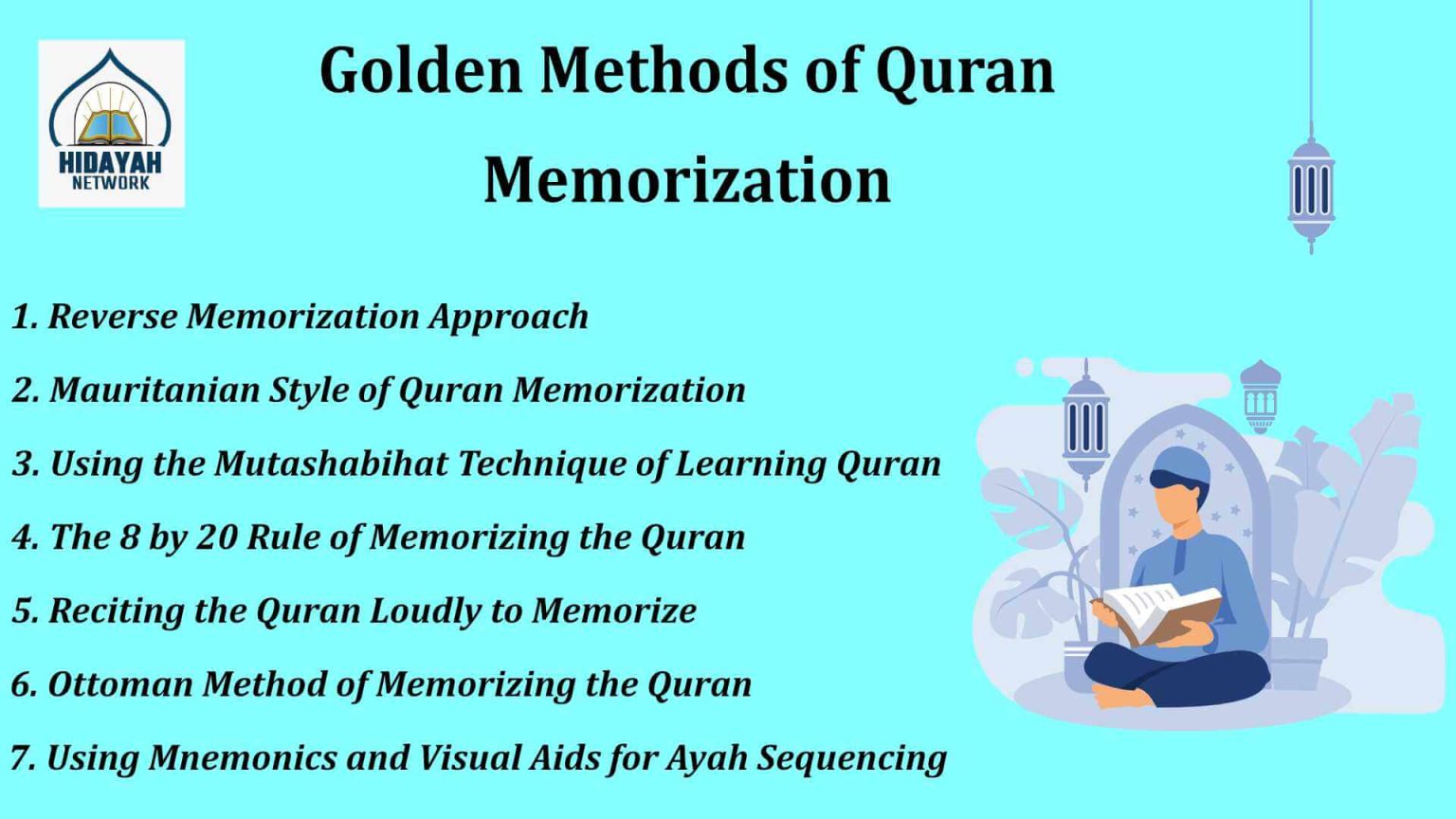Golden methods of Quran memorization refer to those proven techniques that enable the Hafiz to memorize the Quran and never forget it. We will share with you here seven golden methods of memorizing the Quran that will ensure you can memorize the Quran from start to finish without facing any challenges.
The golden methods of Quran memorization are the Ottoman method, using the Mutashabihat techniques of memorizing Quran, the 8 by 20 rule, reciting the Quran loudly to memorize Ayahs, the Mauritanian method, and more. Let’s read about each of these methods in more detail to truly understand how to memorize the Quran and instill the sacred text in your memory.
Table of Contents
Toggle7 Golden Methods of Quran Memorization
1. Reverse Memorization Approach
Utilizing the reverse memorization approach in Quranic memorization involves starting from the last verse of a surah and gradually working backward. This technique taps into the psychological principle of the primacy-recency effect, enhancing retention by focusing on the beginning and end of a passage.
For instance, when memorizing Surah Al-Fatiha in reverse, one begins with “Maaliki yawmi addeen” (Master of the Day of Judgment) and progresses backward. This method is particularly one of the ideal Quran memorization tips in reinforcing the conclusion of each surah, often containing summaries or key messages.
2. Mauritanian Style of Quran Memorization
The Mauritanian style of Quran memorization emphasizes quality over quantity, focusing on perfecting the recitation and understanding of each verse before moving forward.
This method involves reciting a verse multiple times with correct pronunciation, intonation, and Tajweed rules, ensuring a deep connection with the words. An example of this technique is to take a single verse, like “Inna ma’al usri yusra” (Indeed, with hardship [will be] ease) from Surah Ash-Sharh (94:6) and spend dedicated time perfecting its recitation.
Get 40% OFF Now!
3. Using the Mutashabihat Technique of Learning Quran
The Mutashabihat technique involves memorizing and understanding verses that share common themes or words. For example, when learning verses that discuss mercy, such as “Wa Rahmati wasi’at kulla shay” (And My Mercy encompasses all things) from Surah Al-A’raaf (7:156), one can connect it with other verses expressing divine mercy.
This associative approach not only aids in memorization but also enhances comprehension by establishing thematic connections in order not to forget the verses and their similarities.
4. The 8 by 20 Rule of Memorizing the Quran
The 8 by 20 rule breaks down the Quranic memorization process into manageable segments by memorizing eight verses daily and reviewing the last twenty. For example, one might start with Surah Al-Fatiha and the first seven verses of Surah Al-Baqarah on the first day, reviewing these verses and adding the next eight on the second day.
This method ensures consistent progress while maintaining a strong focus on revision. By consistently revisiting the last twenty verses, learners reinforce their memory and solidify them in their long-term recollections.
5. Reciting the Quran Loudly to Memorize
auditory and vocal senses, creating a multisensory experience that aids retention. When reciting verses aloud, the brain processes information through hearing and speaking, reinforcing the memorization.
For instance, when memorizing Surah Al-Ikhlas (112:1-4), reciting “Qul Huwa Allahu Ahad” aloud allows the learner to hear the words and feel the vibration of their voice. This tactile aspect adds a kinesthetic dimension, immersing the memorization process.
6. Ottoman Method of Memorizing the Quran
The Ottoman method of memorizing the Quran is characterized by a systematic and structured approach that divides the Quran into smaller sections for focused learning. For example, when memorizing Surah Al-Fatiha and the first ten verses of Surah Al-Baqarah, learners follow a pattern of recitation and repetition.
The method involves reciting the verses individually, then collectively, gradually building up to reciting the entire portion seamlessly. Additionally, the Ottoman method emphasizes writing the memorized verses, reinforcing visual and tactile memory.
7. Using Mnemonics and Visual Aids for Ayah Sequencing
Incorporating mnemonics and visual aids into Quranic memorization offers a creative and personalized approach to remembering the sequence of verses. For example, when memorizing the first few verses of Surah Al-Mulk (67:1-5), creating a mental image or association for each verse can significantly aid recall.
Visualizing a protective shield (Mulk) for “Tabarakal-lazi biyadihil mulk” (Blessed is He in whose hand is the dominion) can help anchor the verse in memory. Mnemonics, such as creating acronyms or word associations, add a layer of creativity to the memorization process.
Can I Memorize the Entire Quran by Myself?
It is possible to memorize the entire Quran independently, but it necessitates an intensive quran memorization schedule, unwavering dedication, and a systematic approach. Individuals embarking on this journey must allocate consistent, focused time each day for memorization, understanding that the process is gradual and requires perseverance.
Establishing a routine incorporating review sessions is crucial for reinforcing previously memorized sections. Utilizing effective Quran memorization techniques, such as repetition and recitation, and incorporating various learning styles can enhance the efficiency of the memorization process.
Final Words
Beginning on the remarkable journey of memorizing the Quran is a profound endeavor beyond mere recitation—a spiritual connection and an everlasting bond with the divine words. Whether choosing to follow innovative memorization techniques, enrolling in online hifz classes, or adopting personalized strategies, the commitment to this noble pursuit is a testament to one’s dedication to the teachings of the Quran.

About Author

